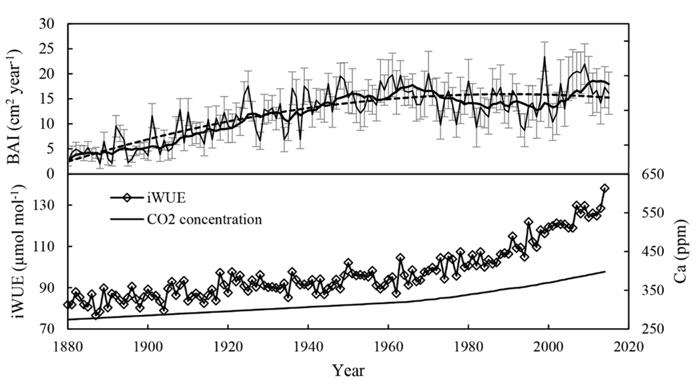| Tweet | Follow @co2science |
Paper Reviewed
Weiwei, L.U., Xinxiao, Y.U., Guodong, J.I.A., Hanzhi, L.I. and Ziqiang, L.I.U. 2018. Responses of intrinsic water-use efficiency and tree growth to climate change in semi-arid areas of north China. Scientific Reports 8: 308, doi: 10.1038/s41598-017-18694-z.
Dendrochronological methods and stable isotope analyses are commonly used on tree ring cores in an effort to discern long-term tree growth and water use efficiency. Such records, when viewed in concert with changes in other atmospheric/climatic variables (e.g., temperature, precipitation, atmospheric CO2 concentration) are helpful in formulating predictions of future forest responses to anthropogenic-induced global warming.
Recently, the scientific team of Weiwei et al. (2018) carried out just such a study, coring Platycladus orientalis trees, an evergreen coniferous species endemic to China, to investigate trends in tree-ring carbon discrimination and intrinsic water use efficiency (iWUE) over the past century in the Hongmenchuan watershed of the Yanshan Mountains. Results of their analysis are presented in the figure below.
As indicated there, both iWUE and tree-ring averaged basal area increment (BAI, a measure of tree growth) have increased with time. What is more, both of these variables were positively correlated with atmospheric CO2 concentration, which findings, the authors say, "are consistent with other studies conducted on the effects of elevated CO2 on leaf physiological activity, which demonstrate that increased CO2 promotes water use efficiency [and BAI], albeit the relationship they observed between BAI and CO2 was much stronger before 1970 than after.
What makes the above findings encouraging is that they occurred despite a 0.39°C per decade increase in mean temperature and an approximate 40% increase in atmospheric CO2 over this same period. Such findings are in stark contrast to those envisioned by climate alarmists, who have long claimed that these supposed "twin atmospheric evils" (i.e., rising temperature and CO2) should be wreaking havoc on ecosystems across the globe. Yet, instead of stunting growth, they have actually been promoting it.

Figure 1. Annual variations in tree-ring averaged basal area increment (BAI, upper panel) and intrinsic water use efficiency (iWUE, lower panel) and atmospheric CO2 concentrations (Ca, also lower panel) between 1880 and 2014 for P. orientalis. Source: Weiwei et al. (2018).




